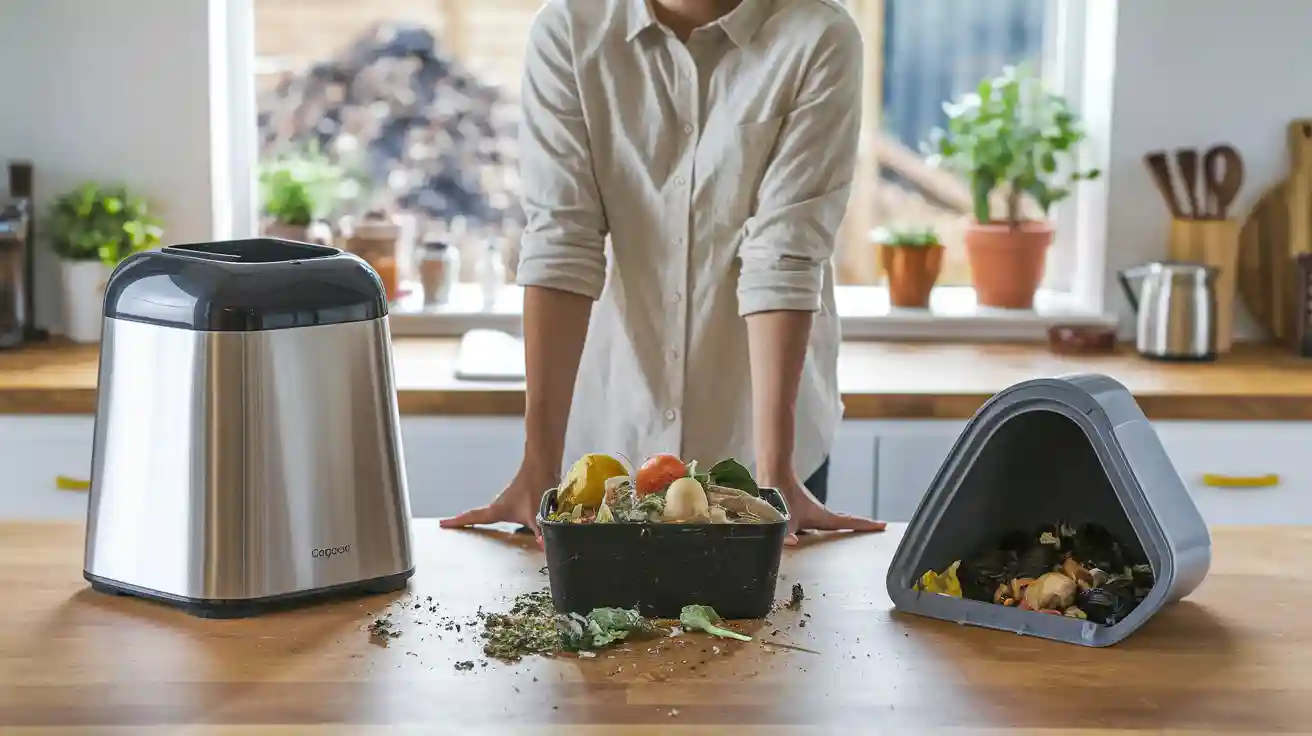
You might find an electric compost maker perfect if you live in a city apartment with limited space and need fast results. Traditional home composting fits best if you want low costs and high compost quality. Only about 4% of U.S. households compost, so every effort matters.
Electric Compost Maker vs. Traditional Composting: Key Differences
Electric Composting and Traditional Methods Compared
You might wonder how electric composting stacks up against traditional composting methods. The table below highlights the main differences:
| Operational Aspect | Electric Compost Makers | Traditional Composting Methods |
|---|---|---|
| Speed | Completes composting in hours to a few weeks using heat, fans, and shredders. | Takes weeks to months for decomposition. |
| System | Closed system reduces odors and pests, works well indoors or in small spaces. | Open system, usually outdoors, exposed to weather and pests. |
| Space Requirements | Compact size fits apartments, patios, or small homes. | Needs outdoor space, often a larger area. |
| Odor and Pest Control | Less odor and fewer pests due to sealed design. | More odors and pests possible because of exposure. |
| Byproduct Nature | Makes a byproduct that may need more curing before use. | Produces compost ready for plants. |
| Limitations | Higher cost, uses electricity, smaller capacity, and needs maintenance. | Low cost, no energy use, larger capacity, but slower process. |
What Makes Each Composting Method Unique
Electric composting uses technology to break down food waste quickly. You can process scraps like meat and dairy, which traditional composting often avoids. Electric compost makers use heat, grinding, and air to turn food waste into a dry material in just a few hours. This method works well indoors and keeps your kitchen free from pests and odors.
Traditional composting relies on natural microbes and takes more time. You need to turn the pile and keep it moist. This method works best outdoors and handles larger amounts of food waste. The finished compost from traditional composting methods is rich in microbes and helps your garden soil. You get a natural, plant-ready product, but you need patience and space.
Both composting options help you reduce food waste at home. You can choose the method that fits your space, time, and needs.
Electric Compost Makers: How They Work and Who They Suit

How Electric Composters Operate
You use an electric compost maker to turn your food scraps into a soil-like material right in your kitchen. The process is simple and automated:
- Place your organic household waste, such as fruit peels and kitchen scraps, into the machine’s hopper.
- Set the machine’s program. It adjusts for waste density, moisture, and temperature.
- The electric composter heats, dries, and grinds the food waste. Microbes help break down the material while a biofilter removes odors.
- After about 24 hours, you remove the finished product, which you can use as a natural fertilizer.
This closed system keeps your home odor-free and makes composting easy, even if you live in a small space.
Pros of Electric Compost Makers
Electric composters offer many benefits:
- You can compost indoors, even in apartments.
- The process is fast, turning food scraps into usable material in less than a day.
- Odor and pests stay away because the system is sealed.
- You can compost year-round, no matter the weather.
- The machine handles a wide range of food waste, including meat and dairy.
- The compact size fits small kitchens and busy lifestyles.
Tip: Electric composting encourages you to reduce food waste because it is so easy and convenient.
Cons of Electric Compost Makers
You should know the drawbacks before choosing an electric composter:
- The output is not true compost. It is a dry, ground material that may need more time to mature.
- Electric composters cost more than traditional bins, often around $400.
- The process uses electricity and does not fully copy natural composting.
- Some users feel confused by marketing claims about the finished product.
- The machine’s capacity is smaller, so you may need to empty it often if you have lots of food scraps.
Best Fit: Who Should Choose an Electric Composter
You might find an electric compost maker perfect if you:
- Live in an apartment or have limited outdoor space.
- Produce moderate to high amounts of food scraps, including meat and dairy.
- Want a low-maintenance, quick composting solution.
- Need odor-free, indoor composting.
- Have a busy lifestyle or live in a place with harsh weather.
Electric composters work best for people who want convenience and speed in managing their food waste.
Traditional Composting Methods: Benefits and Drawbacks
Common Traditional Composting Setups
You can choose from several traditional composting setups for your home. Popular options include:
- Stationary compost bins made from wood, plastic, or metal. These bins keep your compost contained and help control pests.
- Compost tumblers that let you spin the drum for easy aeration. Tumblers work well for smaller batches of food scraps.
- Compost bags, which are easy to set up and store. These work best for seasonal composting or small spaces.
- DIY wire bins made from chicken wire or fencing. You can build these to any size and cover them with a tarp to keep pests away.
When you pick a setup, think about size, placement, pest-proofing, and how easy it is to turn the pile.
Pros of Traditional Composting
Traditional composting offers many benefits:
- Improves soil health by adding nutrients for your plants.
- Makes soil hold water better and drain well.
- Lets you avoid chemical fertilizers and garden naturally.
- Saves money because you buy less fertilizer.
- Reduces household waste and keeps food waste out of landfills.
- Lowers stormwater runoff on your property.
- Gives you choices, like compost tumblers or open piles, to fit your space and needs.
Tip: Traditional composting works well for both yard trimmings and organic household waste.
Cons of Traditional Composting
You should know about the challenges of traditional composting:
- The process takes time, often 6-12 months for full breakdown.
- You need to turn the pile often, which takes effort.
- Weather can slow down composting, especially in cold or dry climates.
- If you do not balance materials, you might get odors.
- Poorly managed piles can attract pests and wildlife.
Best Fit: Who Should Choose Traditional Composting
Traditional composting suits you if you have outdoor space and want to handle food scraps and yard waste naturally. This method works best in places with a mild climate that supports microbial activity. You should choose traditional composting if you can turn the pile and want to improve your garden soil with rich compost. Homes with gardens, lawns, or space for a bin will benefit most from this approach.
Deciding Between Electric Composting and Traditional Composting
Decision Checklist: Lifestyle, Space, and Budget
When you choose between composting methods, you should think about your daily life, the space you have, and your budget. Here is a checklist to help you decide:
- Space: Electric composters fit on kitchen counters or in small apartments. Traditional composting needs a backyard or outdoor area.
- Budget: Electric composters cost between $250 and $899. You also pay for filters, enzymes, and electricity. Traditional composting costs little or nothing to set up and maintain.
- Time: Electric composters work fast, sometimes in just a few hours. Traditional composting takes weeks or months.
- Effort: Electric composters do most of the work for you. You only need to empty the bucket and clean it. Traditional composting needs you to turn the pile and watch the balance of materials.
- Noise and Odor: Electric composters run quietly and use filters to control smells. Traditional composting can have more odors and may attract pests if not managed well.
- Type of Waste: Some electric composters can handle meat and dairy. Traditional composting works best with fruit, vegetables, and yard waste.
- Final Product: Electric composters make a dry, ground-up material that may need more time before you use it on plants. Traditional composting gives you rich, plant-ready compost.
Tip: If you live in a city or have little space, an electric composter may fit your needs. If you have a yard and want to save money, traditional composting could be better.
Here is a quick comparison:
| Aspect | Electric Composters | Traditional Composting |
|---|---|---|
| Initial Cost | $250–$899 | Low or free |
| Ongoing Costs | Filters, enzymes, electricity | Almost none |
| Space Needed | Small, indoor | Large, outdoor |
| Composting Time | Hours to days | Weeks to months |
| Effort | Low | Moderate to high |
| Compost Quality | Needs curing | Ready for plants |
Environmental Impact: What Matters Most?
You want to help the planet when you start composting. Both methods keep food waste out of landfills, but they work in different ways.
Traditional composting uses no electricity. It relies on natural microbes to break down waste. This process creates healthy compost for your garden and does not add to your energy bill. You can compost yard waste and food scraps, making it the most eco-friendly choice. You also avoid the carbon footprint of making and running an electric device.
An electric composter uses energy to heat, grind, and dry your food scraps. Some models use about 5 kWh of electricity each month. This adds a small amount to your carbon footprint. However, electric composters reduce food waste quickly and stop methane gas from forming in landfills. They work well for people who cannot compost outdoors.
Note: If you want the lowest environmental impact, traditional composting is best. If you need a fast, indoor solution, an electric composter still helps reduce waste.
Real-Life Scenarios and Examples
Let’s look at how different people use composting in their homes:
- City Apartment: You live in a small apartment with no outdoor space. You cook often and want to reduce food waste. An electric composter fits on your counter and handles your daily scraps. You like the speed and the fact that it controls odors.
- Suburban Family: You have a backyard and a garden. You want to save money and improve your soil. You set up a compost bin outside. You add yard waste and kitchen scraps. After a few months, you use the finished compost in your garden beds.
- Busy Professional: You have little time for yard work. You want a simple way to manage food waste. An electric composter lets you compost indoors with little effort. You empty the bucket every few days and use the byproduct for your houseplants.
- Eco-Conscious Gardener: You care about the environment and want the best compost for your plants. You choose traditional composting. You turn the pile and watch the balance of green and brown materials. Your garden thrives with the rich compost you make.
Remember: Composting works for many lifestyles. You can pick the method that matches your space, time, and goals.
Myths and Misconceptions About Electric Composters and Traditional Composting
Electric Composters: What They Can and Can’t Do
You might see electric composters advertised as a quick way to turn food scraps into compost. However, these machines do not create true compost. Here are some common misconceptions:
- Electric composters actually produce dried and ground food waste, not finished compost. The process uses high heat and low moisture, which stops the microbes needed for real composting.
- Some brands add microbes or enzymes, but these cannot survive the harsh conditions inside the machine. The result is not stable or safe for immediate use in your garden.
- If you add the output directly to soil, you may notice mold, insects, or bad smells. This shows the material still needs more time to break down.
- Many companies call the output “compost,” but experts say it is only a pre-processed material. You must cure it further before using it as a soil amendment.
- The commercial composting industry follows strict rules and research. Home electric composters do not meet these standards.
Tip: Always let the output from electric composters finish breaking down before using it in your garden.
Traditional Composting: Clearing Up Common Myths
You may hear that traditional composting is hard or messy. In reality, many beliefs about this method are not true:
- You do not need a large yard to start composting. Small bins or tumblers work well on patios or balconies.
- Many people worry about bad smells or pests. If you balance your materials and keep the pile aerated, you can avoid these problems.
- Some think composting takes too much time. With regular care, you can manage a pile in just a few minutes each week.
- Confusion often exists between “biodegradable” and “compostable” items. Only certified compostable products break down fully in a well-managed pile.
- Scientific studies show that traditional composting improves soil health, increases nutrients, and helps the environment by reducing landfill waste.
Remember: Composting at home is easier than you might think, and it brings many benefits to your garden and the planet.
You can match your composting method to your home and lifestyle. Choose a system that fits your space and daily routine. Every effort helps reduce waste and supports healthier soil. Composting at home, whether electric or traditional, improves your environment and benefits your community for years to come.
FAQ
Can you use compost from an electric composter right away?
You should let the output cure for a few weeks. This step helps finish the breakdown process and makes the material safer for your plants.
What food scraps should you avoid in traditional composting?
You should avoid meat, dairy, oily foods, and large bones. These items attract pests and slow down the composting process.
Does composting smell bad?
If you balance green and brown materials, you will not notice strong odors. Turning the pile and keeping it moist also helps control smells.


